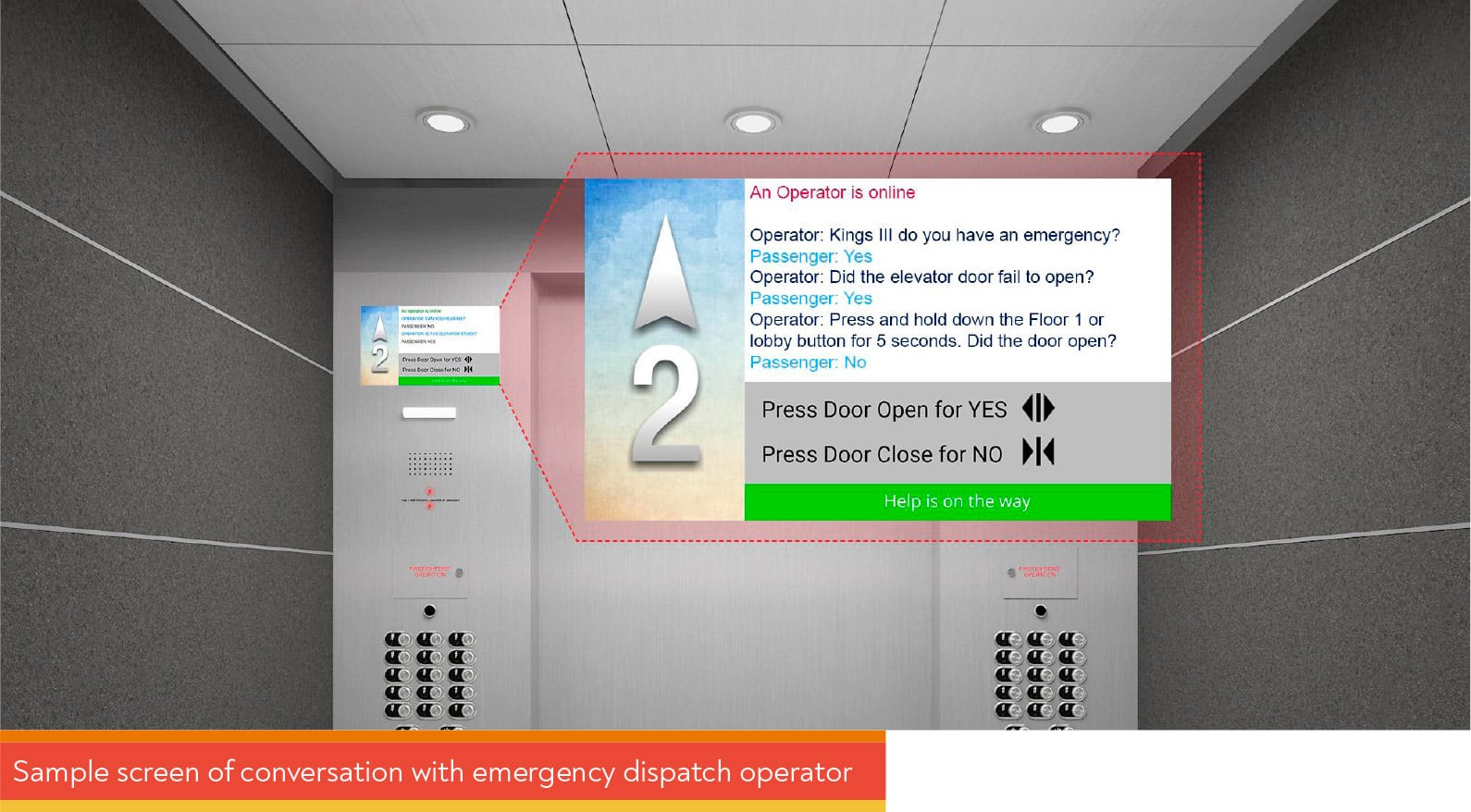Latest code changes mandate stricter requirements for emergency communications.
by Dave Mann and Calvin Linde
With the close of 2019 came the publication of the updated ASME A17.1/CSA B44 Safety Code for Elevators and Escalators. As with any code revision, the question for equipment owners and maintainers/installers becomes, “How will this affect me?” Looking specifically at Section 2.27.1: Car Emergency Signaling Devices, there are a few important additions.
First is the inclusion of requirements specifying how the person answering an entrapment call communicates with those in the elevator. Two-way communication has always been important, but ASME has added language stating, in a nutshell:
- Authorized personnel must be able to communicate with trapped passengers who cannot verbally communicate or hear.
- Monitoring parties must be able to notify those in the elevator that help is on the way.
- There must be a means to display video allowing onsite or remote-monitoring personnel to observe passengers.
So, what does this mean? We’ve all been there when the button is pushed accidentally, and the passengers pretend it didn’t happen or, maybe, just walk out of the elevator. What does a monitoring station do if it doesn’t get an answer? Monitoring stations receive up to 1,000 false calls every day, but what if a rider needs help but can’t be heard?
The intent of the changes is to provide additional assurance, not only for those placing the call for help, but also for those answering the call. If a passenger does not or cannot respond — possibly because they are speech- or hearing-impaired — the new code means emergency personnel will now be able to use a nonverbal means to communicate. This may be accomplished by posting messages in real time on an in-car display. Operators will select prewritten messages, and passengers will be able to respond “yes” or “no” back to the monitoring personnel using the “Door Open” and “Door Closed” push buttons.
The requirement for a one-way video stream allows emergency personnel to see inside the elevator, giving them the ability to better assess the situation, such as confirming whether there is a passenger who cannot respond due to disability or incapacitation. Live, encrypted video of the elevator interior would be available to the remote-monitoring station, local fire control panel or building security desk.
As with most updates, new code requirements will only apply when elevators are permitted for construction or modernization after AHJ adoption. However, a building owner may choose to make upgrades to older or non-modernized elevators on the same property to ensure emergency communication system consistency. This could include elevators of a different age or type from the new installation or modernized elevator(s). When the code does apply, will you be able to comply with the new requirements?
These updates are going to change more than just who answers the phone. Many companies offer call monitoring and answering services, but if elevator emergency calls are not their primary business, will they be able to handle the new logistical challenges? While it seems easy enough to simply open a browser and connect, there are other factors to think about, such as:
- Does the monitoring solution have a backup plan when there is a power outage? Does it have its entire internet network infrastructure on 4-hr. battery backup (as per the code revision)?
- Does your 24/7 monitoring solution have redundancy built in? Can it still answer video and messaging calls any time of day or night, even when its information technology (IT) department takes down the internet connection for network maintenance?
- Is the internet service provider being used reliable and secure?
- Is the monitoring center set up with infrastructure to monitor video? Does it have means to back up the messaging and text messages, and store them for legal reasons?
- Is the team consistently trained to answer calls, including video and messaging? Is there a chance the video and messaging system will accidently not be used when it could have been, which could lead to liability issues?
Meeting Requirements
Kings III Emergency Communications and MAD Elevator have been working on a solution that accomplishes the intent of the new code requirement. MAD provides the hardware component, while Kings III’s monitoring services address the human aspect of responding to elevator entrapments.
MAD’s System
- A passenger places an emergency call by pressing the phone/help button.
- A phone call is placed to the monitoring station through the existing emergency phone system. At the same time, an encrypted tunnel is opened to the monitoring station for video and messaging.
- The monitoring station answers the phone and begins a verbal conversation with the passenger.
- If the passenger does not respond, the monitoring station can visually confirm if there is a passenger in the car, and that it was not an accidental button press.
- If a passenger is present and has not acknowledged spoken communication, the monitoring station can try to communicate by posting written messages to the in-car screen.
- Passengers can either respond verbally or by pressing door open/close buttons to answer “yes” or “no.”
- If there is still no response (or the passenger is unable to respond; e.g., is unconscious), the visual confirmation of a passenger being present enables the monitoring station to dispatch appropriate emergency personnel.
Kings III’s External Monitoring
- The system monitors the phone/help button through a second contact.
- When a passenger presses the button, the monitoring-center system is notified, and video and text message call requests are created for that specific elevator.
- The phone call comes in and is answered.
- When the monitoring station accepts the video and messaging request, an encrypted tunnel between the monitoring station system and elevator is created.
- Through this tunnel, monitoring-center agents review the video feed and communicate to the car and through the two-way text messaging.
Internally Monitored System
How does this work in a building with 24-hr. onsite security staff who monitor internally? For this type of system, an external connection to the internet and creation of the encrypted tunnel is not required, since all devices are on the same network. When the button is pressed, an onsite attendant is notified via video and messaging software on the fire panel or security desk.
Other Concerns
Camera feeds should not have access to the public internet, such as through port forwarding, which can allow hackers to access the camera through possible bugs in the device’s firmware.
You do not want to depend on a firmware password to secure your device from the open internet. Video feeds and messages are susceptible, and the local area network could be spoofed with changed or rerouted messages. All communication should be two-way encrypted to prevent hacking and spoofing.
Networking Considerations
Do you want the emergency communication system to be dependent on an internet connection provided by the building? Can you ensure the system is not accidentally changed, modified or turned off by the building’s IT department or another building contractor? Can you be sure the building network’s infrastructure has 4-hr. backup in place and is adequate? Does each camera, router, switch and modem required have adequate backup? If the system isn’t working, whose responsibility is it? If using a cellular 4G modem for offsite remote monitoring, who is responsible for the SIM card and data plan?
Regardless of the code year adopted by your state, the need to protect your customers and those who ride in their elevators remains the same. As codes change, monitoring requirements become stricter, and inspectors demand more. With video and messaging, elevator companies are starting to evaluate more closely whether continuing to monitor in-house is the right strategy, or if self-monitoring is an unnecessary distraction. Switching between software programs, interfaces and methods from call to call will be difficult. If monitoring is not your core business, is it worth the liability?
A few additional items to consider:
- Is the emergency phone equipment reliable?
- Are calls being answered in a consistent manner?
- Do the operators handling calls have proper training to aid with pre-arrival medical instruction (when needed)?
- Do operators handle the calls with care, understanding that people react to entrapments differently?
- Who is responsible for operator training?
- Can calls be handled in multiple languages?
- Are you line sharing or line seizing? If you are line sharing, what happens when you have simultaneous entrapments?
- Are you recording and storing entrapment calls for your customers for incident reports and liability and/or litigation concerns?
- Does the video and messaging system have full monitoring capability to monitor the 4G cellular or building internet connection, battery backup and video feeds, etc.? Will it notify the building property managers quickly, so they can take corrective action if the system is not operational?
With 18 billion elevator trips in the U.S. annually, elevator malfunctions are inevitable. These additional requirements make how you respond even more important.
Get more of Elevator World. Sign up for our free e-newsletter.










